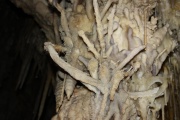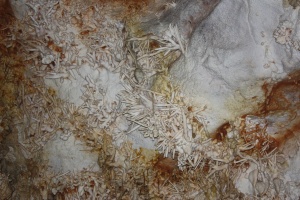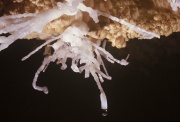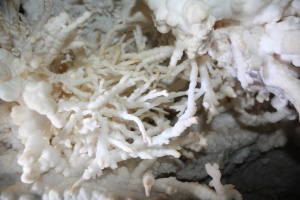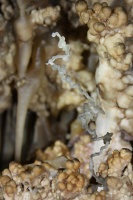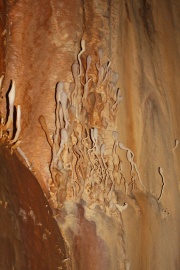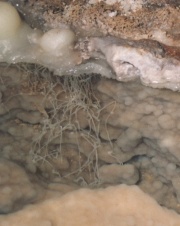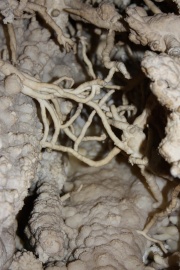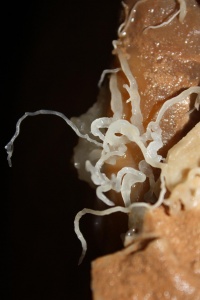Calcite (Inventory)/Helictite
From LagWiki
Contents |
antler
The antler field of the Calcite Helictite section should record stations that exhibit antler helictites.
Like the arms of a deer antler, or the twigs of a branch, antler helictites exhibit straight stems with antler-like tips. The arms of antler helictites are thicker than other helictites (up to 15 cm). The growth is less eccentric in direction than other helictite types. They may or may not be branched. They are usually found on the walls, growing outward, or the floor, growing upward. They may be mixed with various other speleothems including other helictites and anthodites.
See also
References
- Hill, Carol; Paolo Forti (1997) Cave Minerals of the World (Second Edition ed.) National Speleological Society p 77 ISBN: 1-879961-07-5
Antler, Helictite, Calcite
beaded
The beaded field of the Calcite Helictite section should record stations that exhibit beaded helictites.
Like rosary beads on a string, beaded helictites are distinguished from other helictites by small (0.5 to 2mm) diameter beads or bumps on the branches.
Beaded helictites usually appear as fine, branching helictites, white in color. The beads may appear on only a few or all of the branches. These beads are believed to be caused by periodic changes in growth rate. Even though beaded helictites appear in the calcite section of the CCNP Cave Inventory Form they are usually composed of aragonite but can be a mixture of minerals even on the same branch. The branches may be coated with later deposits of calcite making the beads appear less like beads and more like bumps.
See also
References
- Hill, Carol; Paolo Forti (1997) Cave Minerals of the World (Second Edition ed.) National Speleological Society pp 76-77, 145-146 ISBN: 1-879961-07-5
- Palmer, Arthur N. (2007) Cave Geology CAVE BOOKS, Dayton, OH p 285 ISBN-13: 978-0-939748-66-2, ISBN-10: 0-939748-66-5
Beaded, Helictite, Calcite
snake dancer
The snake dancer field of the Calcite Helictite section should record stations that exhibit snake dancer helictites.
Like a snake rising from a charmer's basket, snake dancer helictites grow in a primarily upward direction. They are usually found on the walls or ledges or could grow from other speleothems. The defining characteristic that distinguishes them from other helictities is the upward growth.
Snake dancer helictites are sometimes called heligmites because of their upward growth; but, this name is considered to be inappropriate. Snake dancer helictites often grow from sediments on the floor and in these cases may be the result of water wicking upwardly.
See also
References
- Palmer, Arthur N. (2007) Cave Geology CAVE BOOKS, Dayton, OH pp 285-286 ISBN-13: 978-0-939748-66-2, ISBN-10: 0-939748-66-5
subaqueous
The subaqueous field of the Helictite subsection of the Calcite section should be used to record any observation of subaqueous helictites.
Subaqueous helictites are helictites which form under water. They are formed much like other helictites, but they do not bifurcate or split. They appear as erratic tubes associated with a pool or former pool. They can be observed attached to the rim or walls of the pool and angling downward. They are usually located a couple of meters (3 to 6 feet) downslope from a large gypsum deposit or formation.
Look for subaqueous helictites on the rims and walls of pools or former pools especially if gypsum is nearby.
References
- Pate, Dale. Canyons & Caves; Issue No. 10; Fall 1998; HELICTITES AND SUBAQUEOUS HELICTITES: http://www.nps.gov/cave/planyourvisit/upload/c&c10.pdf
- Hill, Carol; Paolo Forti (1997) Cave Minerals of the World (Second Edition ed.) National Speleological Society p 80 ISBN: 1-879961-07-5
other
The other field of the Calcite Helictite section should record stations that exhibit helictites which are not antler, beaded, snake dancer or subaqueous. Any other type of helictite should be recorded here.
Most helictites found will be inventoried as "other" since they do not have the proper characteristics for more specific categorization. Any helictite which is not thick (antler), growing upwardly (snake dancer), beaded or subaqueous (under water) should be listed in this field.
See also
References
- Palmer, Arthur N. (2007) Cave Geology CAVE BOOKS, Dayton, OH pp 285-286 ISBN-13: 978-0-939748-66-2, ISBN-10: 0-939748-66-5
- Hill, Carol; Paolo Forti (1997) Cave Minerals of the World (Second Edition ed.) National Speleological Society pp 76-81 ISBN: 1-879961-07-5
Other, Helictite, Calcite
